St. Louis Fails At Crosswalks, Part 2
Monday, in Part 1, I explained why St. Louis officials shouldn’t be shocked their colorful art crosswalks don’t meet federal guidelines. They’re less visible than the classic bright white “continental” crosswalk.
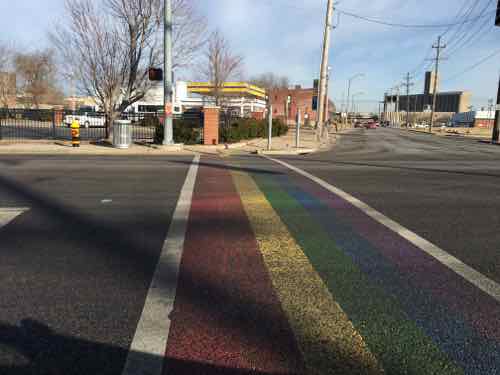

From the Federal Highway Administration (FHA):
8.5 Crosswalks
Crosswalks are a critical part of the pedestrian network. A crosswalk is defined as “the portion of a roadway designated for pedestrians to use in crossing the street” (Institute of Transportation Engineers, 1998). Crosswalks are implied at all intersections whether or not they are marked. Midblock crossings include all marked crosswalks that do not occur at intersections. Midblock crossings are only created if a marked crosswalk is provided. The agency responsible for the roadway must ensure that all marked and unmarked crosswalks and midblock crossings are optimized for the safety and accessibility of all pedestrians.8.5.1 Crosswalk markings
Crosswalk markings, if provided, are used to define the pedestrian path of travel across the roadway and alert drivers to the crosswalk location. Marked crosswalks should be designed in accordance with the Manual of Uniform Traffic Control Devices (MUTCD). Although the MUTCD provides options for crosswalk markings, the continental design is recommended because research indicates that it is the most visible to drivers (Knoblauch et al., 1988). The ladder design is created with white longitudinal lines at a 90 degree angle to the line of the crosswalk. The lines should be approximately 305 mm to 610 mm (12 in to 24 in) wide and spaced 305 mm to 610 mm (12 in to 24 in) apart (USDOT, 1988). The continental design can also be installed so that the primary paths for vehicular tires are between the crosswalk markings, which helps to reduce wear and maintenance. Use of the continental design for crosswalk markings also improves crosswalk detection for people with low vision and cognitive impairments. It is recommended that the continental design be used consistently to mark all crosswalks; otherwise the impact of less visible markings may be weakened by comparison.
They make it very clear that “continental” crosswalk markings are preferred. The design is such that, if properly done, allows vehicle tires to roll over the non-painted areas — thus reducing wear on the paint. The last sentence above is worth repeating:
“It is recommended that the continental design be used consistently to mark all crosswalks;
otherwise the impact of less visible markings may be weakened by comparison.”
Crosswalk markings downtown are anything but consistent, the continental marking is rare.
From the National Association of City Transportation Officials:
While pedestrians generally have the right to cross at any intersection regardless of crosswalks, designers should be sensitive to the misperception that a crosswalk is the only legal place to cross the street. Use crosswalks as both a guide for pedestrians and a way to communicate crossings to motorists.
The practice of discouraging pedestrian crossings by leaving uncontrolled crossings unmarked is not a valid safety measure. Instead, it encourages unsafe, risk-taking behavior and discourages walking citywide. Efforts should be made to enhance or highlight desired crossings wherever practicable. Hybrid beacons, rapid flash beacons, raised crossings, medians, and other safety counter-measures may be suitable and less expensive than full signalization. These should all be considered before leaving an uncontrolled crossing unmarked.
But we can’t afford to mark every possible crossing point — how do we determine when to mark and when to leave unmarked?
All legs of signalized intersections must have marked crosswalks unless pedestrians are prohibited from the roadway or section thereof, or if there is physically no pedestrian access on either corner and no likelihood that access can be provided. Pedestrians are unlikely to comply with a 3-stage crossing and may place themselves in a dangerous situation as a result.
Let’s look at 14th Street from Washington Ave to Olive Street to see how inconsistent St. Louis is with crosswalks:
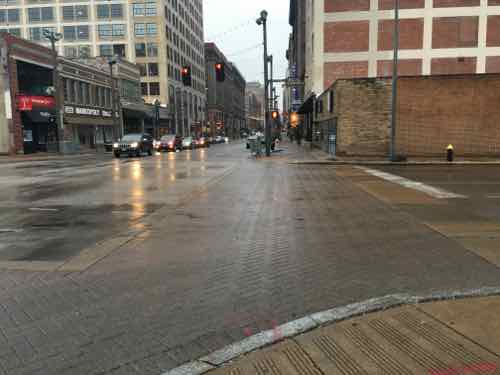
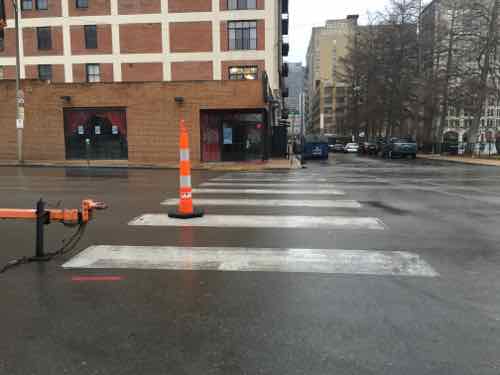
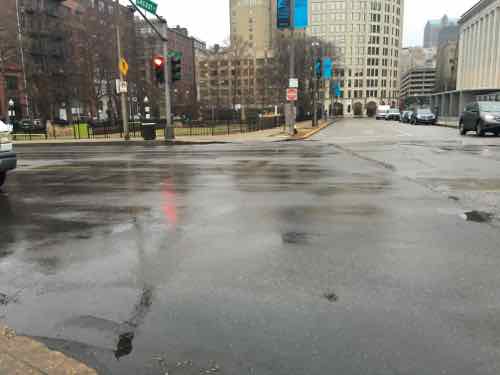
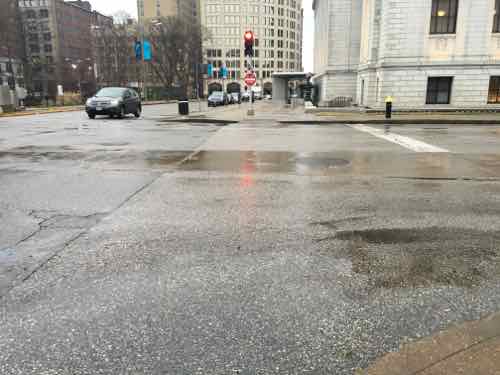
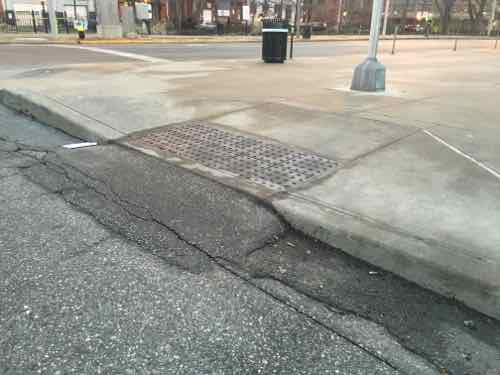
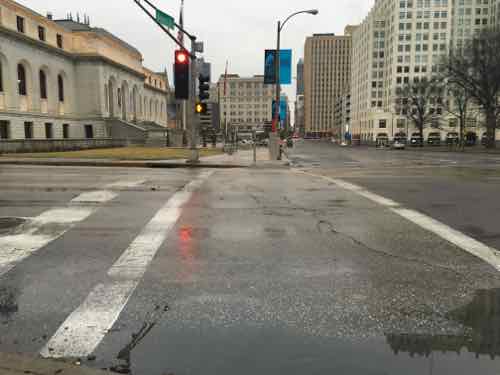
I’d like to think St. Louis’ new bike/ped coordinator will be able to make a difference — but for so long pedestrians got half-ass infrastructure. Not sure one bureaucrat can change the culture.
— Steve Pattersin
I know that I sound like a broken record, but a) show me the money, and b) show me the constituency. Yes, you (and a few others) have been, and contintue to be, vocal advocates for this issue. I support your efforts. But in the bigger scheme of things, it’s an issue that has been, and continues to be, one that can be easily ignored or minimized. No elected official is going to lose an election because of “crosswalks”, Not trying to “save” the Rams or being “soft on crime” are obviously two much bigger issues for most voters!
The city is struggling to maintain ALL of its infrastructure. Yes, the “continental” design IS better – no argument – but it takes 2-3 times as much paint, at every intersection. Using less paint (or no paint) leaves money that can be spent elsewhere, on things like stop signs and cops. It all boils down to tough financial choices and priorities. And if the earnings tax goes away, the degree of difficulty gets exponentially worse . . .
The City isn’t responsible for the rainbow crosswalks nor did they pay for paint or to have them painted. the Grove CID pays for them
Meaning that they are 100% decoration and not intended to meet any regulatory requirements.
Correct
Tim
The city is responsible for the public right-of-way (PROW).
I like creative crosswalks, including one recently installed here in SPI. But the rainbow crosswalk is really tacky, in my opinion. Link to the first (of hopefully many) creative crosswalks in SPI: http://illinoistimes.com/article-16404-making-springfield-cool.html
Different city, similar issues. Big difference is the level of advocacy: http://www.denverpost.com/politics/ci_29534469/denver-residents-push-city-take-charge-needed-sidewalk